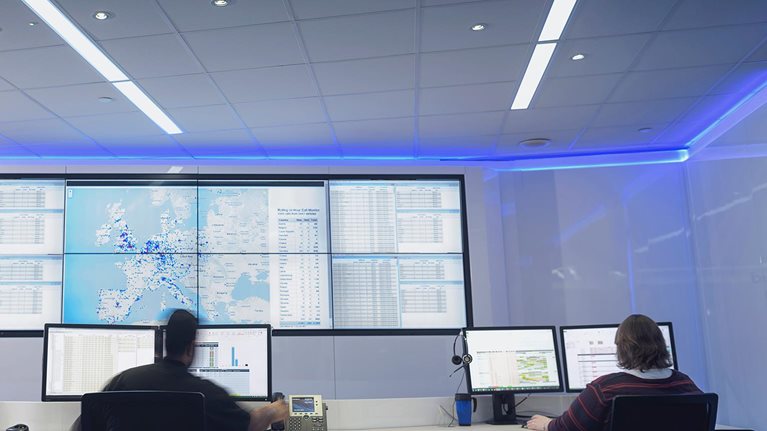The scene is a familiar one: a room filled with people moving with urgency and purpose, surrounded by graphs and charts, alongside desks and chalkboards/flip charts. Some may have the latest technology with computer screens live-streaming data, while others may rely on paper and markers.
In all its shapes, emergency operation centers (EOCs) have been at the core of emergency management since emergency response became a coordinated team activity. With the arrival of the COVID-19 pandemic, health-specific and, more broadly, disaster-focused EOCs have been under pressure like never before. These EOCs assisted in delivering responses at an unprecedented scale globally, especially in the public sector, helping further validate the concept.
Many jurisdictions began activating emergency operation centers (EOCs) in response to the COVID-19 pandemic beginning in March 2020.1 COVID-19 has required public and private sector leaders to leverage existing or create new infrastructure to “coordinate resources, information, and emergency risk communication to respond to the public health threat.”2 That said, as we look forward, we have touched on the potential of additional investments to prevent future pandemics, including the strengthening of resourcing EOCs, with a current global funding gap in the range of between $1 billion to $2 billion. There are also a number of lessons learned in how such EOCs should be set up and operated. We think that six major shifts will likely define how EOCs should pivot going forward in this pandemic and others to come (see Exhibit).

Six design changes for EOCs
1. Target your early warning systems—a smart focus
Early detection gives confidence in deciding to escalate to emergency operations
Here is an illustrative story that combines elements of several experiences over the years. More than a decade ago, a healthcare provider was hacked. A subsequent investigation revealed that many of the issues the hackers exploited were already being monitored by the organization. The problem was that there were so many flashing red lights that they were all ignored—it was impossible to know which red light would turn into a real crisis and which one was a risk that could be contained adequately.
This is a common problem in public health as well. COVID-19 aside, EOCs and responses took from one to four months to be set up for Zika, Ebola (2014, West Africa), and SARS by their respective governments.3
Good early warning systems do not try to predict everything, and neither are they overly specific. They typically pick a finite set of potential issues that satisfy three criteria—high velocity, high impact, and ‘minimum likelihood’ (used as a threshold criterion rather than for explicit prioritization). Then, they define what kind of data is most likely to flag an issue, and how quickly the strength of the signal may increase as the incident grows and gathers speed.
They are clear about what level of these metrics would actually lead to the stand-up of a dedicated EOC to combat the issue, and focus data gathering on getting information about that in as accurate and rapid a manner as possible. For instance, clear evidence of community transmission of a particular virus may be the point at which a formal EOC gets established. The question then becomes what kind of data are needed to define whether community transmission has actually occurred.
Would you like to learn more about our Healthcare Systems & Services Practice?
2. Escalate with practiced protocols—a salsa tempo
Ensure the pivot to emergency operations includes the required protocols
Once the indicators glow red, the fundamental failure that happens next is a human one. History (including COVID-19 history) is rife with examples of individuals within organizations realizing that a big disruption is about to occur, but failing to move the institution to action. Having clear escalation protocols and call-trees that enable leaders to suspend disbelief and focus on switching the organization to emergency operations is critical.
For health EOCs, this may include a clear overview of major triggers (for example, top 10 to 15 diseases for which jurisdiction is most at risk), additional stakeholder mapping in cross-sectional areas (for example, disaster responses, private sector), and a detailed overview of supply chain requirements for core supply (for example, personal protective equipment, essential drugs). For general EOCs, this may include, at least, core technical experts in at-risk areas and their respective response plan, including infectious diseases. This information should ideally be reviewed at a minimum once a year, ensuring the up-to-date nature of the relevant information.
Across all types of EOCs, these protocols may include setting up a “red team” by default. Red teams are dedicated capacity, with a focus on anticipating all potential scenarios, especially the least probable but most disruptive. They challenge existing assumptions and complement the “Standard Operating Procedure” mentality that is necessary but may overlook major disruption risks. This is a frequently overlooked action—a critical element of speed and decision quality in an emergency. For example, an advanced manufacturing organization has a process where, every time the dedicated crisis function within the organization ramps up, a red team dedicated to question and test assumptions is set up in parallel. The red team is typically made up of deep technical experts who have experienced similar situations before. In rare cases, it may include external experts, brought in under legal privilege. These red teams are an important bulwark against optimism and confirmation biases. They act as a powerful balancing force that present a less optimistic picture in crisis situations.
It is hard to definitively ascertain how any of these could have helped institutions in the early days of the COVID-19 crisis. But it is true that organizations that employ red teams are better able to identify the nature of threats that may compound over time (for example, health workers becoming sick while caring for COVID-19 patients)4 and general risks associated with timeline delays (for example, underestimation of time to scale testing).5
3. Embed the EOC with the ability to be decisive, not just tactical
Encourage the EOC to orient and decide faster through a plan-ahead team and portfolio of strategic actions
EOCs should develop sets of relevant operating procedures ahead of a crisis and execute once the time has come. However, it is crucial that EOCs maintain an ability to foresee ahead and adapt, especially ahead of “unknown unknown” factors in a crisis. A pivotal reason why some jurisdictions were able to get ahead of the COVID-19 vaccine rollout was their ability to move from reactive decision making to proactive decision making. This muscle was honed by lessons learned from the first ramp-up around testing and hospital capacity. Some organizations early on in the roll-out anticipated the demand constraints that would come in the months ahead and began working to address them, and similarly carved out capacity to plan for the label expansion to 12- to 15-year-olds and take advantage of any window of opportunity before the end of the academic year.
Across several jurisdictions, this was enabled by a “plan-ahead team.” These teams, working along with EOC leaders, were focused on defining a robust planning scenario that examines possible ways in which the situation can evolve. This allows the core response team to focus on the biggest issues of the day (such as “daily fires”), without mistaking the urgent for the important. These plan-ahead teams could have been particularly effective for heavily burdened areas, including those with vulnerable populations, that may have experienced higher risks of death during the pandemic, both from COVID-19 but also non-COVID-19 causes.6 Ability to foresee additional risks could have prevented additional downstream challenges.
The other job of a plan-ahead team, in the event those were not already developed, is to define a trigger-based portfolio of actions. There are typically a finite number of “big actions” that are available for institutions in any given situation. Working backwards from these allows organizations to be clear about the conditions under which such actions would make sense, which in turn lays the foundation for the kind of data that needs to be collected to inform that decision.
4. Build an ability to coordinate and test quickly outside the organization
Empower the EOC to coordinate across multiple geographies and regions
COVID-19 called for response coordination across international, national, state/provincial, and local actors in ways never previously seen. The pace of the crisis and magnitude of challenges overwhelmed many traditional coordination mechanisms. Between crises, EOCs should create clear, up-to-date mappings of relevant stakeholders. These may span different levels and functions of government but also key partners and associations (for example, medical, business, citizen). COVID-19 highlighted the particular need for stronger connections to the private sector but also to communities.
When schools closed in many parts of the world during the COVID-19 crisis, jurisdictions that had established coordination mechanisms between health and education teams were typically able to react more effectively.7 Regular touchpoints (for example, every six to 12 months) between crises can help keep these relationships warm and ensure that they function smoothly when needed. The frequency of coordination should increase if a crisis threatens and meetings may occur daily during a crisis response. Responsibility for coordination might sit within the EOC or potentially with a dedicated coordination body, such as a Pandemic Preparedness Institute.

Responding to coronavirus: The minimum viable nerve center
5. Reach for better data that cuts through the noise, and an IT infrastructure that can enable that
Build an infrastructure that allows for near real-time data integration
EOC leaders should strive for an underlying IT infrastructure with a desired end state in mind. This system should integrate standardized data, simplify integration and processing of data and enable customizable visualization. This capability can then further be augmented by decision-making tools that inform leaders on key changes (“anomalies”) and vulnerabilities (“risks”). Leaders should access data in near real time, with drill-down capabilities and insight into geographic variability (for example, dynamic changes in equity discrepancies across jurisdictions).
EOC leaders should assume new sources of data will emerge during any crisis and build a system that is sufficiently nimble to allow rapid turnaround of all major phases of data management. Jurisdictions can consider if a cloud-based infrastructure is the right data-hosting solution for them, given its ability to offer rapidly scalable data solutions, incorporation of new capabilities and sources of insights, and more streamlined updates and modifications to historical systems to accommodate new challenges. In addition, interoperability with other platforms, scaling of deployment and portability, and speed of activation should all be considered in envisioning investments in IT infrastructure.
Initially, decision makers within EOCs may need to rely on crude metrics (for example, case numbers). Identifying what those simple metrics would be, ideally in the preparation phase, could help increase quality within data flows (for example, sources, ingestion, integration). In many settings, additional metrics can be anticipated and data management processes can be established to allow incremental insights to come online as quickly as possible. EOC teams can increasingly improve the quality of data over time, identifying additional metrics to track and processes for continuous improvement, but EOC teams should be prepared to “build the plane while flying it.” Speed of decision making cannot be sacrificed in the name of “perfect data.”
Based on recent experience across a variety of types of crises, the following core elements could be considered: data for situational awareness, robust and reliable epidemiological data, data that enables policy comparisons across jurisdictions, and data to track operations (productivity, performance, and capacity). Practically applying these elements requires EOCs to consider the following:
- Define early which metrics will inform decision making and at what threshold (ideally, in the preparation phase against prioritized threats); this minimizes trial and error while easing communications, especially with the public;
- Use proxies with imperfect data as opposed to waiting for perfect, especially early on in the crisis; and
- Understand data on the lowest level and most local way possible as crises are local in nature and require adequate targeting of responses.
6. Make sure your EOC team knows what to expect
Knowing what you will deal with as a team, as a professional, and as a person is critical to building the resilience that the team will rely on when the time comes
Whereas most EOCs will be activated for a given crisis for a short period (for example, under three months), COVID-19 presented a new challenge. The duration of the crisis required ongoing support from the EOC team and at time of publication, represented over 12 months of response in certain jurisdictions. Maintaining efforts for a prolonged period of time is hard. Individuals require constant engagement, often more than six days per week. Long, demanding hours can rapidly lead to burnout, weakening EOC response efforts, especially as it pertains to the quality of the work.
Effective EOC teams build multiple individuals against each position to create redundancies and enable rotations. By doing so, one function does not hinge on one individual for a long period of time. Ensuring EOCs leaders plan for their people can help build resilience and quality of response over time.
It is also crucial that these individuals feel equipped to handle the challenges they will face when crises come. President Dwight D. Eisenhower is often credited with saying that “plans were worthless, but planning was everything.” Drawing up preparedness plans, and running simulations to test them may feel like a waste of time given that the precise scenario one planned for is unlikely to ever happen. The benefit of simulations, however, does not lie in the precision of the plan: it lies in the capabilities and trust it builds within the team. There is no substitute for actually going through a crisis, but a well-designed simulation can successfully recreate moments of difficult choices when the data is not clear. It can help leaders internalize that they will face moments of sheer panic, or hopelessness, or exhaustion, and be better prepared for it when it comes. Those simulations, ideally done in the preparation phase, can take a range of forms: pre-mortems, table-top exercises, simulations. However, they should all translate into actual changes in planning and decision making, to inform future response.
Conclusion
Many institutions have published or are planning to publish recommendations to improve response to health emergencies as a result of the COVID-19 pandemic. Reports to date discuss ongoing financing, agile leadership, social media engagement, and investments in research agendas.8 Concrete tactical actions will be needed to strengthen and reimagine the EOC structure as we know it. COVID-19 may be a once-in-a-generation emergency. But the lessons learned can help future generations prepare.



